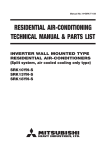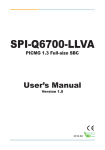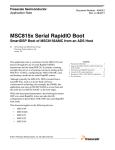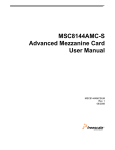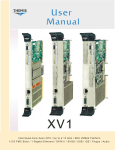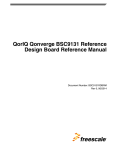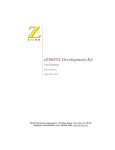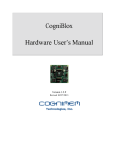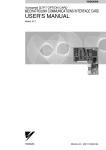Download MSC8156 Advanced Mezzanine Card User`s Manual
Transcript
MSC8156 Advanced Mezzanine Card User’s Manual MSC8156AMCUM Rev. 0 01/2010 How to Reach Us: Home Page: www.freescale.com Web Support: http://www.freescale.com/support USA/Europe or Locations Not Listed: Freescale Semiconductor, Inc. Technical Information Center, EL516 2100 East Elliot Road Tempe, Arizona 85284 +1-800-521-6274 or +1-480-768-2130 www.freescale.com/support Europe, Middle East, and Africa: Freescale Halbleiter Deutschland GmbH Technical Information Center Schatzbogen 7 81829 Muenchen, Germany +44 1296 380 456 (English) +46 8 52200080 (English) +49 89 92103 559 (German) +33 1 69 35 48 48 (French) www.freescale.com/support Information in this document is provided solely to enable system and software implementers to use Freescale Semiconductor products. There are no express or implied copyright licenses granted hereunder to design or fabricate any integrated circuits or integrated circuits based on the information in this document. Freescale Semiconductor reserves the right to make changes without further notice to any products herein. Freescale Semiconductor makes no warranty, representation or guarantee regarding the suitability of its products for any particular purpose, nor does Freescale Semiconductor assume any liability arising out of the application or use of any product or circuit, and specifically disclaims any and all liability, including without limitation consequential or incidental damages. “Typical” parameters which may be provided in Freescale Semiconductor data sheets and/or specifications can and do vary in different applications and actual performance may vary over time. All operating parameters, including “Typicals” must be validated for each customer application by customer’s technical experts. Freescale Semiconductor does not convey any license under its patent rights nor the rights of others. Freescale Semiconductor products are not designed, intended, or authorized for use as components in systems intended for Japan: Freescale Semiconductor Japan Ltd. Headquarters ARCO Tower 15F 1-8-1, Shimo-Meguro, Meguro-ku Tokyo 153-0064 Japan 0120 191014 or +81 3 5437 9125 [email protected] surgical implant into the body, or other applications intended to support or sustain life, Asia/Pacific: Freescale Semiconductor China Ltd. Exchange Building 23F No. 118 Jianguo Road Chaoyang District Beijing 100022 China +86 010 5879 8000 [email protected] unintended or unauthorized use, even if such claim alleges that Freescale For Literature Requests Only: Freescale Semiconductor Literature Distribution Center P.O. Box 5405 Denver, Colorado 80217 +1-800 441-2447 or +1-303-675-2140 Fax: +1-303-675-2150 LDCForFreescaleSemiconductor @hibbertgroup.com Document Number: MSC8156AMCUM Rev. 0, 01/2010 or for any other application in which the failure of the Freescale Semiconductor product could create a situation where personal injury or death may occur. Should Buyer purchase or use Freescale Semiconductor products for any such unintended or unauthorized application, Buyer shall indemnify and hold Freescale Semiconductor and its officers, employees, subsidiaries, affiliates, and distributors harmless against all claims, costs, damages, and expenses, and reasonable attorney fees arising out of, directly or indirectly, any claim of personal injury or death associated with such Semiconductor was negligent regarding the design or manufacture of the part. Freescale, the Freescale logo, and StarCore and the Freescale logo are trademarks or registered trademarks of Freescale Semiconductor, Inc. in the U.S. and other countries. All other product or service names are the property of their respective owners. The Power Architecture and Power.org word marks and the Power and Power.org logos and related marks are trademarks and service marks licensed by Power.org. RapidIO is a registered trademark of the RapidIO Trade Association. ARM is the registered trademark of ARM Limited. ARMnnn is the trademark of ARM Limited. © Freescale Semiconductor, Inc., 2010. All rights reserved. Contents Paragraph Number Title Page Number About This Book Audience ............................................................................................................................ xi Organization....................................................................................................................... xi Suggested Reading............................................................................................................. xi Related Documentation.................................................................................................. xi Conventions ...................................................................................................................... xii Signal Conventions ........................................................................................................... xii Acronyms and Abbreviations .......................................................................................... xiii Chapter 1 Overview 1.1 1.2 1.2.1 1.2.2 1.3 1.4 1.5 1.6 1.6.1 1.6.2 1.7 Introduction...................................................................................................................... 1-1 Working Configuration .................................................................................................... 1-2 Standard AMC Mode................................................................................................... 1-2 Stand-Alone Mode....................................................................................................... 1-2 Features ............................................................................................................................ 1-3 External Connectors......................................................................................................... 1-4 Specifications................................................................................................................... 1-5 Hardware Preparation and Installation ............................................................................ 1-6 Unpacking Instructions ................................................................................................ 1-6 Installation Instructions................................................................................................ 1-6 Memory Map ................................................................................................................... 1-7 Chapter 2 Controls and Indicators 2.1 2.2 2.3 DIP Switches.................................................................................................................... 2-2 LEDs ................................................................................................................................ 2-5 Push Buttons .................................................................................................................... 2-5 Chapter 3 Functional Description 3.1 3.2 3.3 3.3.1 JTAG Debug Interface ..................................................................................................... 3-1 DDR3 Memory ................................................................................................................ 3-2 SerDes Configuration ...................................................................................................... 3-3 SRIO Switch Configuration Modes............................................................................. 3-3 MSC8156 Advanced Mezzanine Card User’s Manual, Rev. 0 Freescale Semiconductor iii Contents Paragraph Number 3.3.2 3.3.3 3.4 3.4.1 3.4.2 3.4.3 3.5 3.6 3.7 3.8 3.9 3.9.1 3.10 3.10.1 3.10.2 3.11 3.12 3.13 3.13.1 3.13.2 3.14 3.14.1 3.14.2 3.14.3 3.15 3.15.1 3.15.2 3.15.3 3.15.4 3.15.5 3.15.6 3.15.7 3.15.8 3.15.9 3.15.10 3.15.11 3.15.12 3.15.13 3.15.14 3.16 3.17 Title Page Number SerDes Clocking .......................................................................................................... 3-5 PCIe Interface .............................................................................................................. 3-6 Gigabit Ethernet Ports...................................................................................................... 3-6 Ethernet Switch Configuration .................................................................................... 3-7 RGMII Clock Delay..................................................................................................... 3-8 Ethernet Transceiver Configuration............................................................................. 3-9 I2C Interface .................................................................................................................. 3-10 SPI.................................................................................................................................. 3-11 UART Interface.............................................................................................................. 3-12 USB Host Interface ....................................................................................................... 3-13 System FPGA ................................................................................................................ 3-13 FPGA SPI Master Interface ....................................................................................... 3-13 Reset Operation and Configuration ............................................................................... 3-14 RCW from Hard Coded Option 1 .............................................................................. 3-15 Loading RCW from External I2C.............................................................................. 3-16 GPIO/Timers and Interrupts........................................................................................... 3-18 Mezzanine Board Identification Pins............................................................................. 3-19 AMC Connector............................................................................................................. 3-19 AMC Backplane JTAG.............................................................................................. 3-22 AMC Backplane Telecom Clocks.............................................................................. 3-22 Power Supply System .................................................................................................... 3-23 Power Options............................................................................................................ 3-23 Power Supplies .......................................................................................................... 3-23 Power Sequence......................................................................................................... 3-26 MMC.............................................................................................................................. 3-26 Reset........................................................................................................................... 3-27 JTAG .......................................................................................................................... 3-27 Serial Debug Interface (UART0) ............................................................................... 3-27 Payload Interface (UART1) ....................................................................................... 3-28 Voltage Monitoring .................................................................................................... 3-28 IPMB.......................................................................................................................... 3-28 Geographical Address................................................................................................ 3-28 Hot Swap Interface .................................................................................................... 3-28 MMC LEDs ............................................................................................................... 3-29 Temperature Sensor ................................................................................................... 3-29 Power Control Through GPIO................................................................................... 3-29 MMC to FPGA Interface ........................................................................................... 3-29 FRU Data ................................................................................................................... 3-29 Stand-Alone Mode..................................................................................................... 3-29 Expansion Card.............................................................................................................. 3-30 Mechanicals ................................................................................................................... 3-31 MSC8156 Advanced Mezzanine Card User’s Manual, Rev. 0 iv Freescale Semiconductor Contents Paragraph Number 3.17.1 3.17.2 3.18 Title Page Number Layout ........................................................................................................................ 3-31 Heatsink ..................................................................................................................... 3-31 Rapid Prototyping Systems............................................................................................ 3-32 Appendix A JTAG Configuration File Listing Appendix B FRU Data MSC8156 Advanced Mezzanine Card User’s Manual, Rev. 0 Freescale Semiconductor v Contents Paragraph Number Title Page Number MSC8156 Advanced Mezzanine Card User’s Manual, Rev. 0 vi Freescale Semiconductor Figures Figure Number Title Page Number Figures 1-1 1-2 1-3 2-1 2-2 2-3 3-1 3-2 3-3 3-4 3-5 3-6 3-7 3-8 3-9 3-10 3-11 3-12 3-13 3-14 3-15 3-16 3-17 3-18 MSC8156 AMC Block Diagram............................................................................................. 1-2 MSC8156 AMC External Connections................................................................................... 1-4 MSC8156 AMC Expansion card ............................................................................................ 1-5 MSC8156 AMC Switches, Jumpers, and Push Button Locations .......................................... 2-1 MSC8156 AMC LEDs and Push Button Locations................................................................ 2-2 MSC8156 AMC—Default Switch Configuration................................................................... 2-3 JTAG Header for MSC8156.................................................................................................... 3-1 MSC8156 JTAG Chain Options.............................................................................................. 3-2 SerDes Configuration.............................................................................................................. 3-3 SerDes Clocking ..................................................................................................................... 3-6 Ethernet Connectivity ............................................................................................................. 3-7 Ethernet Configuration............................................................................................................ 3-7 I2C Bus ................................................................................................................................. 3-11 SPI ........................................................................................................................................ 3-12 MSC8156 AMC UART to USB Interfaces........................................................................... 3-12 FPGA Functions.................................................................................................................... 3-14 Reset and Configuration Control .......................................................................................... 3-18 Telecom Clocks..................................................................................................................... 3-23 Power Architecture ............................................................................................................... 3-24 MMC..................................................................................................................................... 3-27 Expansion Card Connectors.................................................................................................. 3-31 MSC8156 Mezzanine Heatsink ........................................................................................... 3-32 AMC Base Card and Heatsinks ............................................................................................ 3-32 Rapid Prototyping Systems ................................................................................................... 3-33 MSC8156 Advanced Mezzanine Card User’s Manual, Rev. 0 Freescale Semiconductor vii Figures Figure Number Title Page Number MSC8156 Advanced Mezzanine Card User’s Manual, Rev. 0 viii Freescale Semiconductor Tables Table Number Title Page Number Tables i 1-1 1-2 1-3 2-1 2-2 2-3 2-4 3-1 3-2 3-3 3-4 3-5 3-6 3-7 3-8 3-9 3-10 3-11 3-12 3-13 3-14 3-15 3-16 3-17 3-18 Acronyms and Abbreviations.................................................................................................. xiii Environmental Specifications ................................................................................................. 1-5 MSC8156 AMC Top Level Specification............................................................................... 1-5 MSC8156 Memory Map ......................................................................................................... 1-7 DIP Switch Setting Descriptions............................................................................................. 2-4 MSC8156 Clock Values .......................................................................................................... 2-5 LED Description ..................................................................................................................... 2-5 MSC8156 AMC Push Button Switches .................................................................................. 2-6 SRIO Switch Configuration (Boot-Master Mode).................................................................. 3-4 SRIO Switch Configuration (Boot-Slave Mode) .................................................................... 3-4 VSC7384 Port Mapping.......................................................................................................... 3-7 Ethernet Switch Register Accesses ......................................................................................... 3-8 MSC8156 RGMII Delay (Prototype Build)............................................................................ 3-9 CMODE Configuration Settings ............................................................................................. 3-9 I2C Addresses........................................................................................................................ 3-10 RCWLR (Hard Coded) ......................................................................................................... 3-15 RCWHR (Hard Coded) ......................................................................................................... 3-16 RCWLR (Load from I2C) ..................................................................................................... 3-17 RCWHR (Load from I2C)..................................................................................................... 3-17 GPIO/Timer and IRQ Signals Connected to FPGA.............................................................. 3-19 AMC Connector Signal Pin Definitions ............................................................................... 3-20 VCORE Margining ............................................................................................................... 3-24 Single Voltage Generator Modifications............................................................................... 3-25 Power Sequencing Requirements.......................................................................................... 3-26 Hot Swap Sequence .............................................................................................................. 3-28 Connectors ............................................................................................................................ 3-30 MSC8156 Advanced Mezzanine Card User’s Manual, Rev. 0 Freescale Semiconductor ix Tables Table Number Title Page Number MSC8156 Advanced Mezzanine Card User’s Manual, Rev. 0 x Freescale Semiconductor About This Book This user manual defines the functionality of MSC8156 AMC. MSC8156 AMC is a complete advanced mezzanine card development system for engineers developing applications and systems for the MSC8156 digital signal processor. Audience It is assumed that the reader understands operating systems, microprocessor system design, and the basic principles of RISC processing. Organization Following is a summary and a brief description of the chapters of this user manual: • Chapter 1, “Overview ,” provides a detailed descripition of components, working configuration, features, external connectors, characterstics and specifications, hardware preparation and intallation, and memory map of MSC8156 AMC. • Chapter 2, “Controls and Indicators,” elucidates on controls and indicators, such as switches, jumpers, LEDs, and push button switches of MSC8156 AMC processor board. • Chapter 3, “Functional Description,” describes the various functional blocks in the MSC8156 AMC, how they are used, and the available configuration options. Suggested Reading This section lists additional reading that provides background for the information in this manual as well as general information about the architecture. Related Documentation Freescale documentation relevant to this kit is available from the following sources: • MSC8156 Technical Data Sheet • MSC8156 Reference Manual • MSC8156 AMC Hardware Getting Started Guide • MSC8156 Mezzanine Hardware Design Description • AMC Base Card Hardware Design Description Additional literature is published as new processors become available. For a current list of documentation, refer to www.freescale.com. Additional documentation relevant to this kit is available from the following sources: • PICMG AMC.0 R2.0 “Advanced Mezzanine Card Base Specification” MSC8156 Advanced Mezzanine Card User’s Manual, Rev. 0 Freescale Semiconductor xi About This Book • PICMG 2.15 “PCI Telecom Mezzanine/Carrier Card Specification” Conventions This document uses the following notational conventions: cleared/set When a bit takes the value zero, it is said to be cleared; when it takes a value of one, it is said to be set. mnemonics Instruction mnemonics are shown in lowercase bold italics Italics indicate variable command parameters, for example, bcctrx Book titles in text are set in italics Internal signals are set in lowercase italics, for example, core int 0x0 Prefix to denote hexadecimal number 0b0 Prefix to denote binary number rA, rB Instruction syntax used to identify a source GPR rD Instruction syntax used to identify a destination GPR REG[FIELD] Abbreviations for registers are shown in uppercase text. Specific bits, fields, or ranges appear in brackets. For example, MSR[LE] refers to the little-endian mode enable bit in the machine state register. x In some contexts, such as signal encodings, an unitalicized x indicates a don’t care. x An italicized x indicates an alphanumeric variable n An italicized n indicates a numeric variable ¬ NOT logical operator & AND logical operator | OR logical operator || Concatenation, for example, TCR[WPEXT] || TCR[WP] — Indicates a reserved bit field in an e500 register. Although these bits can be written to as ones or zeros, they are always read as zeros. Signal Conventions OVERBAR lowercase_italics lowercase_plaintext An overbar indicates that a signal is active-low Lowercase italics is used to indicate internal signals Lowercase plain text is used to indicate signals that are used for configuration. MSC8156 Advanced Mezzanine Card User’s Manual, Rev. 0 xii Freescale Semiconductor About This Book Acronyms and Abbreviations Table i contains acronyms and abbreviations used in this document. Table i. Acronyms and Abbreviations Term Meaning AMC Advanced mezzanine card (AdvancedMC™) ATCA Advanced telecommunications computing architecture BDM Background debug mode BTS Base transceiver station CPLD Complex programmable logic device DIP Dual in-line package DNP Do not populate DSP Digital signal processor EEPROM Electrically erasable, programmable read-only memory FPGA Field programmable gate array FRU Field replaceable unit GETH Gigabit Ethernet HSC High-speed connector HW Hardware I 2C Inter-integrated circuit IPMB-L Intelligent platform management bus-local IPMC(V) Intelligent platform management controller (voltage) IPMI Intelligent platform management interface LTE Long-term evolution MMC Module management controller MTCA Microtelecommunications computing architecture ( MicroTCA™) RCW Reset configuration word sRIO Serial rapid IO UART Universal asynchronous receiver/transmitter UEC UCC Gigabit Ethernet controller WIMAX Worldwide interoperability for microwave access xTCA ATCA, uTCA, picoTCA chassis or equivalent MSC8156 Advanced Mezzanine Card User’s Manual, Rev. 0 Freescale Semiconductor xiii About This Book MSC8156 Advanced Mezzanine Card User’s Manual, Rev. 0 xiv Freescale Semiconductor Chapter 1 Overview Freescale’s MSC8156 AMC is a complete advanced mezzanine card (AMC) development system for engineers developing applications and systems for the MSC8156 digital signal processor (DSP). 1.1 Introduction The MSC8156 AMC is a high-density, single-width, full-height advanced mezzanine card DSP platform based around three MSC8156 DSPs. The MSC8156 delivers a high level of performance and integration, combining six, fully programmable SC3850 DSP cores, each running at 1 GHz. Each MSC8156 has 1 Gbyte of associated 64-bit-wide DDR3 memory split into two banks. For data plane applications, high-throughput 3.125-GHz ×4 RapidIO links connect the three MSC8156s to each other and to the data backplane through IDT’s high-bandwidth 10-port (×4) CPS10Q SRIO switch. Data or control plane applications are handled by the 1-Gbyte Ethernet interfaces. Two 1000 Base-X 1-Gbyte interfaces connect the backplane to the MSC8156s through an Ethernet switch. Each MSC8156 has 2-Gbyte reduced gigabit media-independent interface (RGMII) connected to the Ethernet switch. Two additional gigabit Ethernet interfaces are provided at the front panel for test and control. For bootstrap purposes, a common serial I2C bus and EEPROM is connected between the MSC8156s. Board control and hot swapping are provided by the Pigeon-Point-based module management controller (MMC).To facilitate debug and development, a number of headers and connectors have been offloaded to an expansion card. MSC8156 AMC has been designed around a mezzanine concept to aid future development. The mezzanines provide the system building blocks, enabling future AMC prototyping systems to be quickly realized. Figure 1-1 shows the block diagram of MSC8156 AMC. MSC8156AMC Advanced Mezzanine Card User’s Manual, Rev. 0 Freescale Semiconductor 1-1 Overview Figure 1-1. MSC8156 AMC Block Diagram 1.2 Working Configuration MSC8156 AMC can be configured in any of the following two modes: • Standard AMC mode • Stand-alone mode 1.2.1 Standard AMC Mode Freescale recommends running the MSC8156 AMC in an ATCA, microTCA, picoTCA chassis, or equivalent (xTCA). This enables the correct power and air flow to be delivered to the board. The MSC8156 AMC has been designed to work in any chassis that accepts full-height modules. 1.2.2 Stand-Alone Mode Although not a standard AMC configuration, the MSC8156 AMC runs stand-alone. An optional external 12-V power supply barrel connector is used for stand-alone operation. (The MSC8156ADS power supply can be used here.) Note that this connector violates the AMC component envelope. For further details on running the MSC8156 AMC in stand-alone mode, contact the local FAE. NOTE In stand-alone mode, ensure that adequate cooling is provided for the board to prevent board damage. MSC8156AMC Advanced Mezzanine Card User’s Manual, Rev. 0 1-2 Freescale Semiconductor Overview 1.3 Features The main features of MSC8156 AMC are as follows: • Form factor — Single-width AMC size, full-height module • Three MSC8156 DSPs — Powerful and flexible DSP with six SC3850 Starcore® cores at 1 GHz and up to 48,000 MMACS per device — Multiaccelerator platform engine for baseband (MAPLE-B) — Programmable Turbo and Viterbi decoders — Two banks of 512-Mbyte 64-bit DDR3 800 per MSC8156 • SerDes connectivity — Full-SRIO connectivity among MSC8156s, and between MSC8156s and backplane ports — Each MSC8156 with two x4 3.125-GHz SRIO ports connected to SRIO switch — Four backplane ports from port lanes [4:7], [8:11], [12:15], and [17:20] connected to SRIO switch — Option to route SRIO/PCIe from single MSC8156 to backplane port [4:7], bypassing SRIO switch • Ethernet connectivity — Each MSC8156 with two RGMII ports connected to Ethernet switch — 1000 Base-X gigabit Ethernet from backplane ports [0] and [1] routed to MSC8156s through Ethernet switch — Two gigabit Ethernet interfaces routed to front panel RJ45s • Peripherals — MSC8156 UART interfaces multiplexed through the FPGA to a single mini-USB B connector on the front panel through a UART/USB transceiver — I2C bus connecting MSC8156s for boot and configuration — Serial peripheral interface (SPI) bus connecting MSC8156s to on-board serial flash • Booting ability — MSC8156 boot through SRIO over backplane — MSC8156 boot from on-board I2C EEPROM • Debugging ability — JTAG header provided for MSC8156 access — Expansion card enabling access to FPGA and MMC headers — Two DIL switches provide configuration and debug options • MMC — Hot swapping — FRU storage — Status LEDs MSC8156 Advanced Mezzanine Card User’s Manual, Rev. 0 Freescale Semiconductor 1-3 Overview • 1.4 — Temperature and voltage monitoring Power supply — 12-V payload and 3.3-V IPMCV, provided from AMC edge connector — 12-V barrel connector (optional) for stand-alone work — On-board voltage requirements are generated through DC–DC voltage regulators External Connectors The MSC8156 AMC interconnects with external devices through the following set of connectors (see Figure 1-2 and Figure 1-3): 1. AMC connector for connecting to xTCA backplanes 2. MSC8156 OnCE™ 14-pin debug connector 3. Mini-USB type B (UART) 4. RJ45 Ethernet connector 5. Integrated RJ45 and USB type A (USB is not used in MSC8156 AMC) 6. Stand-alone power connector (optional) 7. Expansion connector giving access to the following: a) FPGA programming header b) MMC programming header c) MMC UART payload header d) MMC UART serial debug interface header Figure 1-2. MSC8156 AMC External Connections MSC8156AMC Advanced Mezzanine Card User’s Manual, Rev. 0 1-4 Freescale Semiconductor Overview Figure 1-3. MSC8156 AMC Expansion card 1.5 Specifications Table 1-1 describes the environmental specifications that should be adhered to when operating the MSC8156 AMC. Table 1-1. Environmental Specifications Characteristics Specifications Power requirements No external power supply for AMC mode powered from xTCA chassis In stand-alone mode, the recommended PSU should supply 12 V at 5 A Operating temperature 0–70 ºC Storage temperature −25 ºC to 85 ºC Relative humidity 5–90% (noncondensing) Dimensions Single-width AMC form factor Length = 180.6 mm Width = 73.5 mm PCB thickness = 1.6 mm Table 1-2. MSC8156 AMC Top Level Specification Characteristics MSC8156 Specifications Six cores each running at 1 GHz MSC8156 Advanced Mezzanine Card User’s Manual, Rev. 0 Freescale Semiconductor 1-5 Overview Table 1-2. MSC8156 AMC Top Level Specification Memory (per MSC8156) Memory (per AMC) Com Ports 1.6 Internal M3 1 Mbyte of shared M3 DDR 1 Gbyte of 64-bit-wide DDR3 800 split between two memory banks I2C EEPROM 64-Kbyte serial EEPROM for boot code SPI Flash 16 Mbyte of SPI Flash GETH 2 RJ45 ports at front panel 2 1000 Base-X at backplane SRIO 2 SRIO ports ( x1/x4) Hardware configurable to 1.25, 2.5, and 3.125 GHz data rates UART RS232 transceiver allows data exchange at 115 Kbps Hardware Preparation and Installation This chapter provides unpacking instructions, hardware preparation, and installation instructions for the MSC8156 AMC processor board. For more details on hardware preparation, refer to MSC8156 AMC Hardware Getting Started Guide. 1.6.1 Unpacking Instructions Perform the following step-by-step instructions to unpack the equipment: 1. Unpack the equipment from shipping carton. 2. Refer to packing list and verify that all items are present. 3. Save packing material for storing and reshipping of the equipment. NOTE If the shipping carton is damaged upon receipt, request carrier’s agent to be present during unpacking and inspection of the equipment. CAUTION Avoid touching the areas of integrated circuitry; static discharge can damage circuits. 1.6.2 Installation Instructions Do the following in the order indicated to install the MSC8156 AMC processor board properly: 1. Verify that jumpers and switches are in default positions (see Chapter 2, “Controls and Indicators,” for a list of default positions). 2. Connect external cables as per your requirement (see Section 1.4, “External Connectors,” for more details). 3. Insert the board into the carrier or chassis as per the specific chassis operating instructions. 4. Switch on the power to the chassis. MSC8156AMC Advanced Mezzanine Card User’s Manual, Rev. 0 1-6 Freescale Semiconductor Overview 5. Check for completion of the reset sequence indicated by the LEDs. See Chapter 2, “Controls and Indicators,” for more information. a) When the AMC is powered up (hot swap handle inserted), the blue LED on the front panel flashes and then stays off . b) The five LEDs D1–D5 flash on and then go off. D5 starts blinking to indicate the board is powered up and alive. c) Any Ethernet activity is indicated by D4. 6. Hit the front panel push button to reset the board. 7. Hit the reset button on the MSC8156 AMC secondary side to reset the board. 8. Operate CodeWarrior to verify that the board has been installed properly. 1.7 Memory Map Each of the three MSC8156s has an identical memory map as described in Table 1-3. Table 1-3. MSC8156 Memory Map Address Range Memory Type Device Name Size 0x40000000–0x5FFFFFFF DDR3 (Memory Controller 1) 4× 16-bit-wide MT41J64M16LA-15E 512 M 0x60000000–0x7FFFFFFF Reserved Empty space 512 M 0x80000000–0x9FFFFFFF DDR3 (Memory Controller 2) 4× 16-bit-wide MT41J64M16LA-15E 512 M 0xA0080000–0xBFFFFFFF Reserved Empty space 512 M 0xC0000000–0xC0107FFF M3 memory Internal 1 M + 32 K 0xC0108000–0xFECFFFFF Reserved Empty space 511 M – 32 K 0xFED00000–0xFEDFFFFF MAPLE-B Internal 1M 0xFEE00000–0xFEE3FFFF QUICC engine subsystem Internal 256 K 0xFEE40000–0xFEEFFFFF Reserved (QUICC engine subsystem) Internal 768 K 0xFEF00000–0xFEF17FFF Boot ROM Internal 96 K 0xFEF18000–0xFEFFFFFF Reserved Empty Space 928 K MSC8156 Advanced Mezzanine Card User’s Manual, Rev. 0 Freescale Semiconductor 1-7 Overview MSC8156AMC Advanced Mezzanine Card User’s Manual, Rev. 0 1-8 Freescale Semiconductor Chapter 2 Controls and Indicators This chapter describes controls and indicators for the MSC8156 AMC processor board, such as switches, jumpers, LEDs, and push button switches. Figure 2-1 shows the locations of swiches, jumpers, and push buttons, whereas Figure 2-2 shows the locations of LEDs and push buttons for MSC8156 AMC. Figure 2-1. MSC8156 AMC Switches, Jumpers, and Push Button Locations MSC8156 Advanced Mezzanine Card User’s Manual, Rev. 0 Freescale Semiconductor 2-1 Controls and Indicators Figure 2-2. MSC8156 AMC LEDs and Push Button Locations 2.1 DIP Switches Figure 2-3 shows the location on the board of the DIP switches and their default position. Table 2-1 describes the possible settings of the switches. Note that when the switch is ON, its value is zero. For more detailed description of the bits and fields, see the MSC8156 Reference Manual. Before changing any settings, check if the board is operational and ensure the default positions of the switches. MSC8156 Advanced Mezzanine Card User’s Manual, Rev. 0 2-2 Freescale Semiconductor Controls and Indicators Figure 2-3. MSC8156 AMC—Default Switch Configuration MSC8156 Advanced Mezzanine Card User’s Manual, Rev. 0 Freescale Semiconductor 2-3 Controls and Indicators Table 2-1. DIP Switch Setting Descriptions Switch Position 1 2 3 4 5 6 7 8 ON ON ON ON ON OFF ON ON JTAG0 JTAG1 UART0 UART1 SRIO0 SRIO1 BYPASS RCW_SRC 1 1 2 3 4 5 6 7 8 1 Settings 0 ON ON ON ON ON ON ON ON DEBUG CPS10Q BOOT 12C BUS SerDes_CLK0 SerDes_CLK1 – WORKING CONFIG – 0 Comments SW2.1/SW2.2 ON ON ON OFF OFF ON OFF OFF Select JTAG chain Full chain (x3) (default) DSP1 only DSP2 only DSP3 only SW2.3/SW2.4 ON ON ON OFF OFF ON OFF OFF Select UART Ethernet switch (default) DSP1 DSP2 DSP3 SW2.5/SW2.6 ON ON ON OFF OFF ON OFF OFF SRIO switch frequency 1.25 GHz 3.125 GHz (default) 2.5 GHz Illegal mode SW2.7 ON OFF DSP1 port 1 SerDes bypass Connects to SRIO switch (default) Connects direct to backplane port[4:7] SW2.8 ON OFF Reset configuration word source I2C, Boot port = SRIO (default) Hard coded option 1 SW1.1 ON OFF DSP debug mode Debug mode is off [EE0=0](default) Debug mode is on [EE0=1] SW1.2 ON OFF CPS10Q boot mode Boot from EEPROM (default) Slave mode SW1.3 ON OFF I2C bus Separate CPS10Q and DSP I2C bus (default) Combined CPS10Q and DSP I2C bus SW1.4/SW1.5 ON ON ON OFF OFF ON OFF OFF DSP1 SerDes clock source 125 MHz SRIO clock (default) Not applicable 100 MHz PCIe from backplane 100 MHz PCIe from on-board oscillator SW1.6 ON Future use SW1.7 OFF ON Working configuration Stand-alone mode xTCA chassis (default) SW1.8 ON Future use The MSC8156 clock settings, which are derived from SW2.8, are described in Table 2-2. MSC8156 Advanced Mezzanine Card User’s Manual, Rev. 0 2-4 Freescale Semiconductor Controls and Indicators Table 2-2. MSC8156 Clock Values Clock 2.2 SW2.8 = ON (MHz) SW2.8 = OFF (MHz) CLKIN 100 100 PLL0 900 900 PLL1 1000 1000 PLL2 800 800 CLASS 900 900 DSP core subsystem 1000 1000 HSSI 333 333 QUICC engine 500 500 MAPLE 450 450 DDR controller 1 800 800 DDR controller 2 800 800 CLKOUT 100 80 LEDs Table 2-3 describes the MSC8156 AMC processor board LEDs. Table 2-3. LED Description Description Ref Color LED ON LED OFF DSP1 D1 Green User programmable User programmable DSP2 D2 Green User programmable User programmable DSP3 D3 Green User programmable User programmable Port 0 Ethernet activity D4 Yellow Flash: Ethernet activity ON: Link No link Board alive indicator D5 Yellow Flash for board running Payload power off Front panel (blue hot swap) D7 Blue Hot swap status Hot swap status Front panel (red: out of service) D8 Red Fault condition Normal operation Front panel (green: in service) D9 Green Not implemented Not implemented UART activity D32 Orange Flash for activity Off for no activity Section 3.15, “MMC” describes in detail the function of the MSC8156 AMC front panel LEDs (D7–D9). 2.3 Push Buttons Table 2-4 describes the MSC8156 AMC processor board push buttons. MSC8156 Advanced Mezzanine Card User’s Manual, Rev. 0 Freescale Semiconductor 2-5 Controls and Indicators Table 2-4. MSC8156 AMC Push Button Switches SW3 Board Reset Pressing push button on the front panel resets the board SW4 Board Reset Pressing push button on the back of the board resets the board MSC8156 Advanced Mezzanine Card User’s Manual, Rev. 0 2-6 Freescale Semiconductor Chapter 3 Functional Description This chapter describes the various functional blocks in the MSC8156 AMC, how they are used, and the options available for their configuration. 3.1 JTAG Debug Interface Each of the MSC8156’s JTAG debug ports is connected to the FPGA. The FPGA then combines them into a chain based on the switch SW2.1 and SW2.2 selection, as shown in Figure 3-2. A single JTAG connector (Samtec TSM-107-01-S-DV-P) on the board enables to connect to the MSC8156s (see Figure 3-1). The signals available on the JTAG connector are as follows: • TMS: This signal is pulled up so that after reset 5, TCK clocks put the TAP into the test logic reset state. • TSRT: The reset signal is pulled low to force the JTAG into reset by default. • TCK: The clock signal is pulled low to save power in low-power stop mode. • TDI: The input signal is pulled high to save power in low-power stop mode. All JTAG ports have a weak internal TDI pull up. • TDO: The output signal is pulled high. • HRESET: This signal is pulled high and connects to the FPGA. Figure 3-1 defines the pin out of the connector. Figure 3-1. JTAG Header for MSC8156 The JTAG chain listing used with the CodeWarrior tools is described in Appendix A, “JTAG Configuration File Listing.” MSC8156AMC Advanced Mezzanine Card User’s Manual, Rev. 0 Freescale Semiconductor 3-1 Functional Description Figure 3-2. MSC8156 JTAG Chain Options 3.2 DDR3 Memory Each DSP supports dual 64-bit DDR3 controllers. The MSC8156 AMC design utilizes both memory controllers attaching 512 Mbytes of DDR3 memory to each. The 512 Mbytes of DDR3 is constructed using 4 (1 Gbit) Micron MT41J64M16BLA-15E devices (8 Mbytes × 16 bits × 8 banks). The DDR3-SDRAM is configured with 13-row address lines, 10-column address lines, and 8 banks. Control of each memory device is through the CS0 signal. NOTE EEC is not supported in the MSC8156 AMC design. Complex DDR3 timing adaptation is available through the DDR clocking subsystem of the MSC8156. It supports the following: 1. Positioning of the DQS output signals relative to the data during writes to DDR memory 2. Sampling of input data from DDR memory 3. Synchronizing the incoming DDR data to the internal clock 4. Controling the relationship between output data and CLK_OUT 5. Write leveling MSC8156 Advanced Mezzanine Card User’s Manual, Rev. 0 3-2 Freescale Semiconductor Functional Description 6. Read leveling 7. ZQ calibration The DDR3 interface operates with 1.5 V I/O and 0.75 VTT voltages, which are supplied from the AMC base card. 3.3 SerDes Configuration Each DSP contains two ×4 SerDes ports, which are independent, configurable, multilane serial ports supporting serial RapidIO, PCIe, and SGMII. The MSC8156 AMC is primarily an SRIO-based system, and both SerDes ports on all the three DSPs are configured for x4 serial RapidIO operation (referenced as SRIO0 and SRIO1) and connected to the SRIO switch. The one exception is the second SerDes port on DSP1, which can be configured to bypass the SRIO switch through high-speed SerDes multiplexers, and can be connected directly to the backplane ports [4:7]. This enables the specific port to be configured as SRIO or PCIe. This SRIO switch bypass option is controlled through switch SW2.7. The SRIO switch connects four SRIO ports to the backplane. Two of these connections connect to the fat pipes section of the AMC connector ports [4:7] and ports [8:11]. The final two ports connect to the extended options backplane ports [12:15] and [17:20]. Figure 3-3. SerDes Configuration 3.3.1 SRIO Switch Configuration Modes The CPS10Q SRIO switch can be configured through the following two different interfaces: 1. On power up through the I2C EEPROM (boot-master mode) MSC8156 Advanced Mezzanine Card User’s Manual, Rev. 0 Freescale Semiconductor 3-3 Functional Description 2. In band through a CPU/ DSP attached to one of the SRIO ports (boot-slave mode) This is a switch configurable option (SW1.2), and the default is for the SRIO switch to be configured through its dedicated EEPROM on power up. Table 3-1 details the configuration and port mappings of the SRIO switch following power up and configuration from the EEPROM. In boot-master mode, the CPS10Q powers up and reads configuration data from the EERPOM to configure all ports into Standard 4x mode. The frequency selection of the port among 1.25, 2.5, or 3.125 GHz speed is configured directly from switches SW2.5 and SW2.6. Table 3-1. SRIO Switch Configuration (Boot-Master Mode) Switch Lane Port Mode Port Number End Point 3:0 Standard 4x 0 DSP2 SRIO0 7:4 Standard 4x 1 DSP2 SRIO1 11:8 Standard 4x 2 DSP3 SRIO0 15:12 Standard 4x 3 DSP3 SRIO1 16:19 Standard 4x 4 AMC SRIO1 23:20 Standard 4x 5 AMC SRIO2 27:24 Standard 4x 6 AMC SRIO0 31:28 Standard 4x 7 AMC SRIO3 35:32 Standard 4x 8 DSP1 SRIO0 36:39 Standard 4x 9 DSP1 SRIO1 In boot-slave mode, the SRIO switch receives no configuration data on power up and boots into a default state. In this mode, an SRIO host would be expected to configure the switch by maintenance transactions. Table 3-2 details the configuration of the switch in boot-slave mode. Table 3-2. SRIO Switch Configuration (Boot-Slave Mode) Switch Lane Port Mode Port Number End Point 3:0 Standard 4x 0 DSP2 SRIO0 7:4 Standard 4x 1 DSP2 SRIO1 11:8 Standard 4x 2 DSP3 SRIO0 15:12 Standard 4x 3 DSP3 SRIO1 16 Enhanced 1x 4 AMC SRIO1 17 Enhanced 1x 5 18 Enhanced 1x 6 19 Enhanced 1x 7 23:20 Standard 4x 8 AMC SRIO2 27:24 Standard 4x 9 AMC SRIO0 MSC8156 Advanced Mezzanine Card User’s Manual, Rev. 0 3-4 Freescale Semiconductor Functional Description Table 3-2. SRIO Switch Configuration (Boot-Slave Mode) (continued) Switch Lane Port Mode Port Number End Point 31:28 Standard 4x 10 AMC SRIO3 35:32 Standard 4x 11 DSP1 SRIO0 36 Enhanced 1x 12 DSP1 SRIO1 37 Enhanced 1x 13 38 Enhanced 1x 14 39 Enhanced 1x 15 Further details on the enhanced and standard SRIO switch operating modes can be obtained from the CPS10Q data sheet. NOTE The SRIO switch’s EEPROM is factory configured over the I2C bus using an MSC8156 as the programmer. 3.3.2 SerDes Clocking All MSC8156 SRIO SerDes blocks and the CPS10Q SRIO switch run with a fixed 156.25-MHz clock, enabling them to run at 3.125, 2.5, or 1.25 GHz depending on the selected SRIO speed. As DSP1 SRIO can be configured as PCIe, it has the additional option of running from either an on-board 100-MHz PCI clock or receiving a PCI clock direct from the backplane, as shown in Figure 3-4. Switches SW1.5 and SW1.5 are used to select the clock through the clock multiplexers. MSC8156 Advanced Mezzanine Card User’s Manual, Rev. 0 Freescale Semiconductor 3-5 Functional Description Figure 3-4. SerDes Clocking 3.3.3 PCIe Interface The second DSP1 SerDes interface can be configured to run as PCIe by bypassing the SRIO switch and selecting the appropriate PCI clock. Running in PCIe also requires an MSC8156 AMC firmware update. For further details, contact the local Freescale FAE. 3.4 Gigabit Ethernet Ports Each MSC8156 has 2-Gbit Ethernet controllers (GE1 and GE2) that can be configured independently for RGMII or SGMII operation. As the SGMII pins are multiplexed with the SRIO interface and the SerDes block is configured for SRIO operation, the RGMII interface is used for Ethernet. A Vitesse VSC7384 12-port RGMII Ethernet switch provides the switching fabric among the DSPs, the AMC backplane ports, and front panel RJ45s. In total, it switches 10 Ethernet sources as shown in Figure 3-5. A Vitesse VSC8224 quad-port transceiver is used to switch from RGMII to 1000-Base-X on the backplane ports [0:1], and from RGMII to twisted pair or RJ45 on the front panel. The RJ45 contains integrated magnetics with two indicator LEDs. MSC8156 Advanced Mezzanine Card User’s Manual, Rev. 0 3-6 Freescale Semiconductor Functional Description Figure 3-5. Ethernet Connectivity 3.4.1 Ethernet Switch Configuration On power up, the FPGA configures the Ethernet switch’s internal microcontroller through its SPI . The Ethernet switch in turn configures the VSC8224 transceiver directly through its management interface. Figure 3-6. Ethernet Configuration Table 3-3 summarizes the Ethernet switch port mappings. Table 3-3. VSC7384 Port Mapping VSC7384 Port Interconnect Interface Target 0 RGMII (full duplex, Gigabit mode) DSP1 (GE1) 1 RGMII (full duplex, Gigabit mode) DSP1 (GE2) MSC8156 Advanced Mezzanine Card User’s Manual, Rev. 0 Freescale Semiconductor 3-7 Functional Description Table 3-3. VSC7384 Port Mapping (continued) VSC7384 Port Interconnect Interface Target 2 RGMII (full duplex, Gigabit mode) DSP2 (GE1) 3 RGMII (full duplex, Gigabit mode) DSP2 (GE2) 4 RGMII (full duplex, Gigabit mode) DSP3 (GE1) 5 RGMII (full duplex, Gigabit mode) DSP3 (GE2) 6 RGMII (full duplex, Gigabit mode) VSC8224 Transceiver [Port 0] 7 RGMII (full duplex, Gigabit mode) VSC8224 Transceiver [Port 1] 8 RGMII (full duplex, Gigabit mode) VSC8224 Transceiver [Port 2] 9 RGMII (full duplex, Gigabit mode) VSC8224 Transceiver [Port 3] 10 Not used — 11 Not used — For debug and analysis, the Ethernet switch registers can be accessed through the Ethernet switch UART. The terminal should be set to 115200 data rate, 8 data bits, and no parity, with echo-typed lines locally set to ON. The complete list of registers is available in the VSC7384 data sheet. An example of some useful register accesses is detailed in Table 3-4. Table 3-4. Ethernet Switch Register Accesses Terminal Input 3.4.2 Register Access Description r120 Read block 1, port 2, register 0x0 Read port 2 MAC configuration register r130 Read block 1, port 3, register 0x0 Read port 3 MAC configuration register r 1 5 0x50 Read block 1, port 5, register 0x50 Read port 5 received octets r 1 5 0x51 Read block 1, port 5, register 0x51 Read port 5 transmitted octets w 1 5 0 0x302F0141 Write block 1, port 5, register 0x0 Write to MAC configuration register RGMII Clock Delay The RGMII specification requires the signal clock to be delayed by 1.5–2 ns at the receiving end of the data path. This clock delay can be added externally (extending clock trace length) or by using internal delays built into the device. The MSC8156 tap value can be selected through the GCR4 register. The default GCR4 value, which is initially set in ROM code, differs between MSC8156 Rev1 silicon (used in Prototype MSC8156 AMC) and MSC8156 Rev2 silicon (used in Pilot MSC8156 AMC). The GE1 track lengths differ on the AMC base card versions to accommodate boot over Ethernet, which uses the default GCR4. NOTE DSP2 GE1 has been changed to accommodate both MSC8156 and QoreIQ mezzanines. MSC8156 Advanced Mezzanine Card User’s Manual, Rev. 0 3-8 Freescale Semiconductor Functional Description Table 3-5. MSC8156 RGMII Delay (Prototype Build) MSC8156 MSC8156 Prototype [Rev 1 MSC8156] MSC8156 Pilot [Rev 2 MSC8156] RX Clock Delay (ns) TX Clock Delay (ns) RX Clock Delay (ns) TX Clock Delay (ns) DSP1 GE1 1.6 1.6 0 0 DSP1 GE2 1.6 1.6 0 0 DSP2 GE1 1.6 1.6 0 0 DSP2 GE2 0 0 0 0 DSP3 GE1 1.6 1.6 0 0 DSP3 GE2 0 0 0 0 3.4.3 Ethernet Transceiver Configuration On power up, the VSC8224 Ethernet transceiver is configured through eight CMODE configuration pins. These configure a subset of the MII registers within the device. The register block is then programmed through the management interface, which connects to the Ethernet switch. Table 3-6 describes the CMODE configuration settings. Table 3-6. CMODE Configuration Settings Name Value Description MAC Interface 000 RGMII with AutoCAT5/serial media sense PHY Address [4:2] 100 Address = b100xx b10000 = Port 0 b10001 = Port 1 b10010 = Port 2 b10011 = Port 3 ActiPHY 0 Disable power management LED4[1:0] LED3[1:0] LED2[1:0] LED1[1:0] LED0[1:0] 00 (not used) 00 (not used) 10 00 (not used) 00 LED0 = Link1000/activity LED2 = Link activity LED pulse stretch/blink 0 Collision, activity, RX, and TX outputs will blink when active LED combine link with activity 1 Indicates link only activity (LED2) LED combine 10/100/1000 with activity 0 Indicate activity only (LED0) LED combine collision with duplex 1 Indicate duplex condition [not used] Speed/duplex auto negotiation advertisement [1:0] 01 10/100/1000Base-T, FDX, 10/100Base-T, HDX,1000Base-X, FDX MSC8156 Advanced Mezzanine Card User’s Manual, Rev. 0 Freescale Semiconductor 3-9 Functional Description Table 3-6. CMODE Configuration Settings (continued) Name Value Description Link speed down shift 1 Enable link speed downshift capability on two-pair cable or after three failed auto-negotiation attempts Pause control[1:0] 11 Advertise 100Base TX Remote fault control [1:0] 00 00 (not used) SIGDET[3:0] 0 Pin is an input RGMII Clock Skew[1:0] 00 No skew The RJ45 LEDs have been configured to be on for link and blink for activity. 3.5 I2C Interface The I2C bus connects the three DSPs, FPGA, and the SRIO switch together, and provides a method for bootstrap and communication, as shown in Figure 3-7. Two EEPROMs (M24512-WMW6T) are provided on the bus: one for the DSPs and the other for the SRIO switch. The DSP EEPROM is at address 0x50, and the DSPs access 0x50 during boot, while the SRIO switch access 0x52 during boot. The SRIO switch can act as master or slave on the bus and is accessed at address 0x42. Table 3-7. I2C Addresses I2C Address Description 0x50 DSP EEPROM 0x52 SRIO switch EEPROM 0x42 SRIO switch A voltage level shifter is used to translate from the 2.5-V DSP IO voltage to the FPGA/CPS10Q 3.3-V IO voltage. MSC8156 Advanced Mezzanine Card User’s Manual, Rev. 0 3-10 Freescale Semiconductor Functional Description Figure 3-7. I2C Bus The two EEPROM slaves are accessed through a DSP master for programming purposes. When programming the EEPROMs, the I2C bus is configured as a single bus through switch SW1.3. During normal MSC8156 AMC operation, the I2C bus is configured as two separate buses through SW1.3, enabling both the DSPs and the SRIO switch to act as master and access the bus at the same time. The SW1.3 switch connects to the voltage transceiver through the FPGA to enable or disable it. 3.6 SPI The MSC8156 SPI allows the exchange of data with other devices containing an SPI. The MSC8156 AMC has 16 Mbyte of flash (Spansion S25FL128P) located on the AMC base card. The DSPs access this flash memory through the SPI bus, which routes through the FPGA. This memory gives the option to boot stand-alone with stored application code. The SPI bus has been routed through the FPGA enabling it to utilize the MSC8156 SPIO pins as GPIO if the SPI option is not used. Note that the SPI is intended for future use, and by default, it is not implemented in the FPGA. MSC8156 Advanced Mezzanine Card User’s Manual, Rev. 0 Freescale Semiconductor 3-11 Functional Description Figure 3-8. SPI 3.7 UART Interface The three DSP UARTs and the Ethernet switch UART are multiplexed in the FPGA and routed to a mini type B USB connector on the front panel. An FTDI FT2232 transceiver carries out the UART to USB conversion. An LED indicates TX or RX activity at the interface. Virtual COM port (VCP) drivers enable the USB device to appear as an additional COM port available to the PC. The driver is available from FTDI at http://www.ftdichip.com/Drivers/VCP.htm. Figure 3-9. MSC8156 AMC UART to USB Interfaces MSC8156 Advanced Mezzanine Card User’s Manual, Rev. 0 3-12 Freescale Semiconductor Functional Description 3.8 USB Host Interface An integrated RJ45/USB type A connector provides a host USB interface for QorIQ AMC development. This is not used in the MSC8156 AMC. 3.9 System FPGA The lattice LFXP2-8E-5FTN256C FPGA provides the following functions: • Controls reset sequence of MSC8156 AMC components • Drives the MSC8156 control and configuration signals • Configures Ethernet switch through SPI • Collects and distributes the GPIO or interrupts on the board • MSC8156 JTAG control • Multiplexes UARTs to the UART or USB transceiver • Collects DIP switch inputs for board control • Controls LED operation 3.9.1 FPGA SPI Master Interface The Ethernet switch has an embedded core to control switch operation. The software image for the core is downloaded to the switch from the FPGA over an SPI, with the FPGA being the SPI host. The FPGA has an 8-Kbyte ROM that contains the program image. A standard lattice USB to single-ended wire programming cable is used to program the FPGA through the programming header, which is located on the expansion card. MSC8156 Advanced Mezzanine Card User’s Manual, Rev. 0 Freescale Semiconductor 3-13 Functional Description Figure 3-10. FPGA Functions 3.10 Reset Operation and Configuration The FPGA controls the reset sequencing and configuration of the DSPs, Ethernet switch, Ethernet PHY, and SRIO switch. The connectivity is shown in Figure 3-11. The reset sequence is described below: 1. On applying the 12-V payload power, the MMC runs through the power up sequence to bring up the voltage rails. 2. Once the voltage rails are up, the MMC sends START_RESET_SEQUENCE command to FPGA through its FPGA_COMM link. 3. The FPGA starts its reset sequencer. 4. Based on the reset configuration word source (RCW_SRC) selection from switch SW1.2, the FPGA drives the RCW_SRC pins. 5. The three MSC8156’s PORESET and HRESET signals are released (the MSC8156 SRESET signal is not used and is pulled high). a) If RCW_SRC = Hard Code Option 1, each DSP configures itself independently with the same fixed reset configuration word (RCW) register settings, as described in Section 3.10.1, “RCW from Hard Coded Option 1.” MSC8156 Advanced Mezzanine Card User’s Manual, Rev. 0 3-14 Freescale Semiconductor Functional Description b) If RCW_SRC = I2C, Boot Port = SRIO, each DSP receives its RCW register settings from the EEPROM through the I2C bus, as described in Section 3.10.2, “Loading RCW from External I2C.” 6. The Ethernet switch and PHY resets are released. 7. The SRIO switch reset is released. 8. The switch initializes itself from its boot EEPROM at address 0x52. 9. The FPGA then downloads the software image for the Ethernet switch core through its dedicated SPI. a) Once download is complete, the FPGA applies a register reset to the Ethernet switch, which then configures itself from its core. b) The switch configures the Ethernet PHY over the MDIO interface. 10. Reset sequence is complete and indicated by the LED D5 heartbeat. 11. The platform is now ready for boot over SRIO or general tools access. 3.10.1 RCW from Hard Coded Option 1 When the MSC8156 is configured to load the hard coded RCW, it configures itself with the default values described in Table 3-8 and Table 3-9. Table 3-8. RCWLR (Hard Coded) RCWLR bit Name Value Description [31:30] CLKO 00 Source is PLL0 [CLKOUT = 80 MHz] 29 — 0 Reserved 28:24 S1P 01010 SerDes port 1, PCIe 1x SGMII1. SGMII2 23:20 S2P 0011 SerDes port 0, RapidIO 4x 3.125 GHz 19:18 0 00 Reserved 17 SCLK2 1 SerDes ref clock = 125 MHz 16 SCLK1 1 SerDes ref clock = 125 MHz 15:6 — 0000000000 Reserved 5:0 MODCK 000000 Clock mode 0 DSP1: RCWLR = 0x0A330000 DSP2: RCWLR = 0x0A330000 DSP3: RCWLR = 0x0A330000 MSC8156 Advanced Mezzanine Card User’s Manual, Rev. 0 Freescale Semiconductor 3-15 Functional Description Table 3-9. RCWHR (Hard Coded) RCW Bit High Name Value Description 31:30 — 00 Reserved 29 EWDT 0 Disable watch dog timer 28 PRDY 0 PCI express not ready 27:24 BPRT 0000 Boot port is SRIO (BPRT value ignored) 23 RIO 1 Host access after boot, enabled 22 RPT 0 RIO pass through disabled 21 RHE 0 RapidIO controller is host 20:19 — 00 Reserved 18 RM 0 Not reset master 17:13 — 00000 Reserved 12 GE1 1 RGMII selected 11 GE2 1 RGMII selected 10 R1A 0 SRIO0 does not accept all device IDs 9 R2A 0 SRIO1 does not accept all device IDs 8:3 Device ID 000000 Device ID = 0 2 — 0 Reserved 1 RMU 0 Access local memory port 0 0 CTLS 1 Common transport type is a large system DSP1: RCWHR = 0x00801801 DSP2: RCWHR = 0x00801801 DSP3: RCWHR = 0x00801801 3.10.2 Loading RCW from External I2C When loading the RCW from external I2C, the DSPs receive their configuration data from an external I2C EEPROM at address 0x50. The FPGA configures DSP1 as the DSP master by asserting STOP_BS = 0, and DSP2 and DSP3 as slave devices by asserting STOP_BS = 1. The DSPs receive their RCW data in the following three stages: 1. DSP1 reads its RCW from I2C EEPROM while holding the two slave DSPs off the I2C bus. To do this, DSP1 uses its GPIO0 and GPIO1 pins to control the STOP_BS pins of the slave DSPs. 2. DSP1 reads the RCW for the two slave devices. It then configures its own I2C controller to emulate an EEPROM at address 0x57. MSC8156 Advanced Mezzanine Card User’s Manual, Rev. 0 3-16 Freescale Semiconductor Functional Description 3. DSP1 releases DSP2’s STOP_BS pin. The released slave then reads its RCW data from I2C address 0x57 (DSP1). Once this has completed, it releases DSP3 that also reads its RCW from I2C address 0x57 (DSP1). Table 3-10 and Table 3-11 describe the RCW data that is stored in the EEPROM. These values represent the default values and can be changed through the CodeWarrior SDOS EEPROM burner utility, if required. Table 3-10. RCWLR (Load from I2C) RCWLR Bit Name Value Description [31:30] CLKO 01 Source is PLL1 [CLKOUT = 100 MHz] 29 — 0 Reserved 28:24 S2P 00011 SerDes Port 0: RapidIO 4x 3.125 GHz 23:20 S1P 0011 SerDes Port 1: RapidIO 4x 3.125 GHz 19:18 — 00 Reserved 17 SCLK2 1 SerDes reference clock = 125 MHz 16 SCLK1 1 SerDes reference clock = 125 MHz 15:8 — 0 Reserved 7 PLL1DIS 0 PLL1 enabled (required for clock mode 0) 6 — - Reserved 5:0 MODCK 000000 Clock mode 0 DSP1: RCWLR = 0x43330000 DSP2: RCWLR = 0x43330000 DSP3: RCWLR = 0x43330000 Table 3-11. RCWHR (Load from I2C) RCW Bit High Name Value Description 31:30 RES 00 Reserved 29 EWDT 0 Disable watch dog timer 28 PRDY 0 PCI express not ready 27:24 BPRT 0001 Boot port = SRIO no I2C 23 RIO 1 Host access after boot, enabled 22 RPT 0 RIO pass through disabled 21 RHE 0 RapidIO controller is agent 20:19 — 00 Reserved 18 RM 1 0 0 DSP1 = Reset master DSP2 = Reset slave DSP3 = Reset slave 17:13 — 00000 Reserved 12 GE1 1 RGMII selected MSC8156 Advanced Mezzanine Card User’s Manual, Rev. 0 Freescale Semiconductor 3-17 Functional Description Table 3-11. RCWHR (Load from I2C) (continued) 11 GE2 1 RGMII selected 10 R1A 0 Do not accept all device IDs 9 R2A 0 Do not accept all device IDs 8:3 Device ID 000000 000001 000010 DSP1 = 000000 DSP2 = 000001 DSP3 = 000010 2 — 0 Reserved 1 RMU 0 Access local memory port 0 0 CTLS 1 Common transport type is a large system DSP1: RCWHR = 0x01841801 DSP2: RCWHR = 0x01801809 DSP3: RCWHR = 0x01801811 Figure 3-11. Reset and Configuration Control 3.11 GPIO/Timers and Interrupts A number of GPIOs, timers, and interrupts are routed from the DSP, Ethernet, and SRIO blocks to the FPGA. These can be configured in the FPGA, as required. Note that some of these signals are multiplexed with the reset configuration signals. Once the reset is complete, the signals revert to the GPIO, timer, or interrupt option. MSC8156 Advanced Mezzanine Card User’s Manual, Rev. 0 3-18 Freescale Semiconductor Functional Description Table 3-12. GPIO/Timer and IRQ Signals Connected to FPGA Signal Comment Each MSC8156 GPIO0/IRQ0 Used for I2C boot control GPIO1/IRQ1 Used for I2C boot control GPIO17 Multiplexed with SPI_SCK GPIO18 Multiplexed with SPI_MOSI GPIO19 Multiplexed with SPI_MISO GPIO20 Multiplexed with SPI_SL GPIO24/TMR1 Multiplexed with RCW_SRC2 GPIO25/TMR2 Multiplexed with RCW_SRC1 GPIO27/TMR4 Multiplexed with RCW_SRC0 GPIO28 Multiplexed with UART_RXD GPIO29 Multiplexed with UART_TXD GPIO30 Multiplexed with I2C_SCL GPIO31 Multiplexed with I2C_SDA INT_OUT Nonmaskable interrupt NMI Nonmaskable interrupt SRIO Switch IRQ — Ethernet Switch GPIO0 — Ethernet Transceiver IRQ 3.12 — Mezzanine Board Identification Pins Three board identification signals BRD_ID[2:0] are used to identify the type of mezzanine located on the AMC base card. These signals are connected to the FPGA to identify the appropriate reset and control flow. The MSC8156 Mezzanine has ID 3b001. 3.13 AMC Connector The backplane edge connector provides connectivity to conductive traces on both sides of the AMC PCB. There are 170 traces in total. The connector interfaces the following: • Four 4x SerDes (16 wire) • Two SGMII Ethernet interfaces MSC8156 Advanced Mezzanine Card User’s Manual, Rev. 0 Freescale Semiconductor 3-19 Functional Description • • • AMC fabric clocks AMC telecom clocks (TCLKA,TCLKB,TCLKC, and TCLKD) AMC JTAG The card is mechanically designed to fit into an AMC slot through this connector. The connector is hard gold plated for improved insertion durability. This connector pin out is described in Table 3-13. Table 3-13. AMC Connector Signal Pin Definitions Pin # AMC Definition Specific Signal Description Pin # AMC Definition Specific Signal Description 01 GND — 170 GND — 02 +12 V — 169 TDI AMC_TDI 03 PS1# PS1_N 168 TDO AMC_TDO 04 MP IPMCV 167 TRST# AMC_TRST 05 GA0 GA0 166 TMS AMC_TMS 06 RSRVD n/c 165 TCLK AMC_TCLK 07 GND — 164 GND — 08 RSRVD n/c 163 TX20+ AMC_SRIO3_TXD_P3 09 +12 V — 162 TX20– AMC_SRIO3_TXD_N3 10 GND — 161 GND — 11 TX0+ AMC_TXD_P0_P 160 RX20+ AMC_SRIO3_RXD_P3 12 TX0– AMC_TXD_P0_N 159 RX20– AMC_SRIO3_RXD_N3 13 GND — 158 GND — 14 RX0+ AMC_RXD_P0_P 157 TX19+ AMC_SRIO3_TXD_P2 15 RX0– AMC_RXD_P0_N 156 TX19– AMC_SRIO3_TXD_N2 16 GND — 155 GND — 17 GA1 GA1 154 RX19+ AMC_SRIO3_RXD_P2 18 +12 V — 155 RX19– AMC_SRIO3_RXD_N2 19 GND — 152 GND — 20 TX1+ AMC_TXD_P0_P 151 TX18+ AMC_SRIO3_TXD_P1 21 TX1– AMC_TXD_P0_N 150 TX18– AMC_SRIO3_TXD_N1 22 GND — 149 GND — 23 RX1+ AMC_RXD_P0_P 151 RX18+ AMC_SRIO3_RXD_P1 24 RX1– AMC_RXD_P0_N 150 RX18– AMC_SRIO3_RXD_N1 25 GND — 146 GND — 26 GA2 GA2 145 TX17+ AMC_SRIO3_TXD_P0 MSC8156 Advanced Mezzanine Card User’s Manual, Rev. 0 3-20 Freescale Semiconductor Functional Description Table 3-13. AMC Connector Signal Pin Definitions (continued) 27 +12 V — 144 TX17– AMC_SRIO3_TXD_N0 28 GND — 143 GND — 29 TX2+ n/c 142 RX17+ AMC_SRIO3_RXD_P0 30 TX2– n/c 141 RX17– AMC_SRIO3_RXD_N0 31 GND — 140 GND — 32 RX2+ n/c 139 TCLKD+ AMC_CLKD_P 33 RX2– n/c 138 TCLKD– AMC_CLKD_N 34 GND — 137 GND — 35 TX3+ n/c 136 TCLKC+ AMC_CLKC_P 36 TX3– n/c 135 TCLKC– AMC_CLKC_N 37 GND — 134 GND — 38 RX3+ n/c 133 TX15+ AMC_SRIO2_TXD_P3 39 RX3– n/c 132 TX15– AMC_SRIO2_TXD_N3 40 GND — 131 GND — 41 ENABLE # ENABLE_N 130 RX15+ AMC_SRIO2_RXD_P3 42 +12 V — 129 RX15– AMC_SRIO2_RXD_N3 43 GND — 128 GND — 44 TX4+ AMC_SRIO0_TXD_P0 127 TX14+ AMC_SRIO2_TXD_P2 45 TX4– AMC_SRIO0_TXD_N0 126 TX14– AMC_SRIO2_TXD_N2 46 GND — 125 GND — 47 RX4+ AMC_SRIO0_RXD_P0 124 RX14+ AMC_SRIO2_RXD_P2 48 RX4– AMC_SRIO0_RXD_N0 123 RX14– AMC_SRIO2_RXD_N2 49 GND — 122 GND — 50 TX5+ AMC_SRIO0_TXD_P1 121 TX13+ AMC_SRIO2_TXD_P1 51 TX5– AMC_SRIO0_TXD_N1 120 TX13– AMC_SRIO2_TXD_N1 52 GND — 119 GND — 53 RX5+ AMC_SRIO0_RXD_P1 118 RX13+ AMC_SRIO2_RXD_P1 54 RX5– AMC_SRIO0_RXD_N1 119 RX13– AMC_SRIO2_RXD_N1 55 GND — 116 GND — 56 SCL_L AMC_SCL 115 TX12+ AMC_SRIO2_TXD_P0 57 +12 V — 114 TX12– AMC_SRIO2_TXD_N0 58 GND — 113 GND — 59 TX6+ AMC_SRIO0_TXD_P2 112 RX12+ AMC_SRIO2_RXD_P0 60 TX6– AMC_SRIO0_TXD_N2 111 RX12– AMC_SRIO2_RXD_N0 MSC8156 Advanced Mezzanine Card User’s Manual, Rev. 0 Freescale Semiconductor 3-21 Functional Description Table 3-13. AMC Connector Signal Pin Definitions (continued) 3.13.1 61 GND — 110 GND — 62 RX6+ AMC_SRIO0_RXD_P2 109 TX11+ AMC_SRIO1_TXD_P3 63 RX6– AMC_SRIO_RXD_N2 108 TX11– AMC_SRIO1_TXD_N3 64 GND — 107 GND — 65 TX7+ AMC_SRIO0_TXD_P3 106 RX11+ AMC_SRIO1_RXD_P3 66 TX7– AMC_SRIO0_TXD_N3 105 RX11– AMC_SRIO1_RXD_N3 67 GND — 104 GND — 68 RX7+ AMC_SRIO0_RXD_P3 103 TX10+ AMC_SRIO1_TXD_P2 69 RX7– AMC_SRIO0_RXD_N3 102 TX10– AMC_SRIO1_TXD_N2 70 GND — 101 GND — 71 SDA_L AMC_SDA 100 RX10+ AMC_SRIO1_RXD_P2 72 +12 V — 99 RX10– AMC_SRIO1_RXD_N2 73 GND — 98 GND — 74 CLKA+ AMC_CLKA_P 97 TX9+ AMC_SRIO1_TXD_P1 75 CLKA– AMC_CLKA_N 96 TX9– AMC_SRIO1_TXD_N1 76 GND — 95 GND — 77 CLKB+ AMC_CLKB_P 94 RX9+ AMC_SRIO1_RXD_P1 78 CLKB– AMC_CLKB_N 93 RX9– AMC_SRIO1_RXD_N1 79 GND — 92 GND — 80 FCLKA+ AMC_FCLK_P 91 TX8+ AMC_SRIO1_TXD_P0 81 FCLKA– AMC_FCLK_N 92 TX8– AMC_SRIO1_TXD_N0 82 GND — 89 GND 83 PS0# PS0_N 88 RX8+ AMC_SRIO1_RXD_P0 84 +12 V — 87 RX8– AMC_SRIO1_RXD_N0 85 GND — 86 GND — AMC Backplane JTAG The backplane JTAG is routed direct to the FPGA for future development work. 3.13.2 AMC Backplane Telecom Clocks The four AMC backplane telecom clocks TCLKA, TCLKB, TCLKC, and TCLKD are connected to the FPGA in emulated mode. This mode uses external biasing resistors, as shown in Figure 3-12. Use of these clocks is application dependent, and the clocks can be routed through the FPGA as required. MSC8156 Advanced Mezzanine Card User’s Manual, Rev. 0 3-22 Freescale Semiconductor Functional Description Figure 3-12. Telecom Clocks 3.14 3.14.1 Power Supply System Power Options There are two possible power options for the card depending on the working mode. • Standard AMC mode — 12 V supplying 60-W payload power through the AMC connector — 3.3 V supplying 150 mA for board management through the AMC connector • Stand-alone mode — 12 V supplying 60-W payload power through the optional barrel connector — On-board DC–DC converter generating the 3.3-V management power from the 12-V input. This converter is controlled through the SW1.7 switch. Freescale recommends running the MSC8156 AMC in standard AMC mode in an xTCA chassis to provide the correct power and cooling. 3.14.2 Power Supplies The required voltages for the card are generated locally on-board from the 12-V supply using DC–DC converters, as shown in Figure 3-13. MSC8156 Advanced Mezzanine Card User’s Manual, Rev. 0 Freescale Semiconductor 3-23 Functional Description Figure 3-13. Power Architecture Three linear LTM4601 power modules are used to supply core power to the three DSPs. This voltage can be adjusted through resistor changes to select between 0.8 V and 1.2 V. By default, the core voltages are set to 1.0 V. In addition, the voltage can be controlled from the MMC through the margining pins of the LTM4601 modules. This enables MMC firmware updates to change the voltage. The margining offset has been set to ±5% of Vout through the LTM4601’s MPGM pin, as described in Table 3-14. Table 3-14. VCORE Margining MARG0 MARG1 MODE VOUT (V) 0 0 No margin 1.0 (default) 0 1 Margin up 1.05 1 0 Margin down 0.95 1 1 No margin 1.0 The option exists to parallel up the three LTM4601s to create a single voltage generator greater than 30 A. In this scenario, the VCORE1 module acts as the master core, which synchronizes with the two slave LTM4601s for a combined output. MSC8156 Advanced Mezzanine Card User’s Manual, Rev. 0 3-24 Freescale Semiconductor Functional Description Table 3-15 describes the configuration changes required on the board. By default, the MSC8156 AMC is configured to operate separate core supplies. Table 3-15. Single Voltage Generator Modifications Separate Core Supplies (Default) Component Single Core Supply R_1 (R279) 90.9 K Replace with 30.1 K KOA RK73H1ETTP3012F R_2 (R290) 90.9 K Replace with 100 pf Kemet C0402C101J4GAC R_3 (R189) 90.9 K Replace with 100 pf Kemet C0402C101J4GAC R_5 (R283) 0Ω DNP R_6 (R287) 0Ω DNP R_7 (R286) 0Ω DNP R_8 (R281) 0Ω DNP R_10 (R194) 0 Ω DNP 0Ω DNP R_12 (R192) 0 Ω DNP R_13 (R195) 0 Ω DNP R_14 (R298) DNP 0Ω R_15 (R296) DNP 0Ω R_16 (R74) DNP 0Ω R_17 (R185) DNP 0Ω R_18 (R285) DNP 0Ω R_19 (R206) DNP 0Ω R_20 (R193) DNP 0Ω R_21 (R284) DNP 0Ω R_22 (R278) DNP 0Ω R_23 (R277) DNP 0Ω LK1 DNP Populate LK4 DNP Populate R_11 (R191) An LTC3414 DC–DC converter generates a separate 1.0 V for the SerDes voltage. This voltage can be adjusted through resistor changes to select between 0.8 V and 1.2 V. By default, the voltage is set to 1.0 V. The option exists to connect the SerDes voltage direct to the core voltage through LK2, 3, and 5 links. By default, these links are not populated, and board runs with separate SerDes and core voltages. The DDR3 voltages (1.5 V/0.75 V) are generated from two power circuits. One circuit generates the voltage for DSP1 and the second for a combination of DSP2 and DSP3. Both circuits can generate DDR2 voltages (1.8 V/0.9 V). The DDR voltage has been split to enable future mezzanines to have a combination of DDR2 and/or DDR3. The MMC drives a signal to the circuitry to select the DDR2 or DDR3 option. MSC8156 Advanced Mezzanine Card User’s Manual, Rev. 0 Freescale Semiconductor 3-25 Functional Description 3.14.3 Power Sequence The board power up sequence is initiated by the MMC that controls the timing of the enable signals to the various DC–DC converters. The power up sequence restrictions are described in Table 3-16. Table 3-16. Power Sequencing Requirements Device Notes Sequence MSC8156 Core voltage first then IO in any order 1V0 then 2V5 FPGA No specific power up options Internal power good signal generated from VCC (1V2) and VCCAUX (3V3) pins, so ensure 2V5 is not last supply up 2V5/3.3V then 1V2 CPS10Q No power sequence requirements – VSC7384 VDD_OUT33 (3V3) ≤ VDD_IO25 (2V5) +1.35 V VDD_PLL (2V5) ≤ VDD_IO25 (2V5) +0.5 V 2V5 then 3V3 VSC8224 No power sequence requirements – To meet the above requirements, the following order is used: VCORE1 ≥ VCORE2 ≥ VCORE3 ≥ 1V0 ≥ 1V8 ≥ 2V5 ≥ 3V3 ≥ 1V2 ≥ 1V5/0V75 3.15 MMC The MMC provides the control of the AMC when operating in an xTCA chassis. It controls areas, such as carrier IPMC communications, power up and hot swap, temperature control, and FRU information. The AMC base card uses the Pigeon-Point MMC solution based on the AVR microprocessor ATmega128. The device contains 128 Kbyte of Flash, 4 Kbyte of SRAM for runtime operation, and 2 Kbyte of EEPROM memory for storage of nonvolatile data. A high-level overview of the MMC architecture is shown Figure 3-14. MSC8156 Advanced Mezzanine Card User’s Manual, Rev. 0 3-26 Freescale Semiconductor Functional Description Figure 3-14. MMC 3.15.1 Reset The reset pin of the AVR is connected to the backplane’s enable signal through logical inverter. Both enable and reset are pulled up through 10 KΩ. The carrier IPMC drives this signal to control the MMC. 3.15.2 JTAG A 10-pin JTAG connector compatible with the ATMEL AVR JTAG ICE tool enables to install firmware over the JTAG interface. The connector is located on the expansion card. 3.15.3 Serial Debug Interface (UART0) The AVR uses UART0 as a serial debug interface (SDI) to output debug and diagnostic information. The UART0 interfaces to a 9-pin RS232 receptacle on the expansion card. The terminal should be set to 9800 8-N-1. A typical output will appear as follows: <_>: BMR-AVR Firmware (v1.5.2), MMC edition. <_>: Pigeon Point Systems (c) Copyright 2004-2007. <_>: Reset type: hard, reset cause: external reset MSC8156 Advanced Mezzanine Card User’s Manual, Rev. 0 Freescale Semiconductor 3-27 Functional Description <_>: <_>: <_>: <_>: <_>: <_>: E-keying link #00 is deactivated E-keying link #01 is deactivated E-keying link #02 is deactivated E-keying link #03 is deactivated Geographic address: UGU IPMB address: 0x7A 3.15.4 Payload Interface (UART1) The payload interface can be used for communication with the payload. The UART1 interfaces to a 9-pin RS232 receptacle on the expansion card. The terminal should be set to 9800 8-N-1. 3.15.5 Voltage Monitoring The AVR monitors the 3.3-V management (IPMCV) and 12-V payload voltages. These are connected to the device’s ADC1 and ADC2 pins. 3.15.6 IPMB The AVR MMC provides an IPMB-L interface using the AVR’s built-in controller. This connects to the AMC edge connector IPMB pins—SDA and SCL—enabling communication with the carrier IPMC resource. The signals are pulled up to IPMC through 3.3-KΩ resistors. 3.15.7 Geographical Address The geographical address (chassis slot location) is implemented using four GPIO pins. The three pins are pulled up to GA_REF through 3.3-KΩ resistors. 3.15.8 Hot Swap Interface The AVR provides a hot swap interface that comprises a hot swap handle and a blue hot swap LED. The hot swap switch is activated by the module latching mechanism and is used to confirm insertion or indicate a request for an extraction to the MMC. This switch signal is pulled up to management power so that it can be read when payload power is not applied. The MMC sends an event to the carrier IPMC when the hot swap switch changes state. The blue hot swap LED is mounted on the front of the face plate. It provides feedback on the hot swap state of the module. It has a number of different states—On, Off, and blink. Full details of the LED operation are described in the PICMG AMC.0 R2.0 Advanced Mezzanine Card Base Specification. Table 3-17 summarizes a typical hot swap sequence. Table 3-17. Hot Swap Sequence Description Hot Swap Handle Hot Swap LED AMC insertion and power up AMC inserted into chassis with handle open Open On MSC8156 Advanced Mezzanine Card User’s Manual, Rev. 0 3-28 Freescale Semiconductor Functional Description Table 3-17. Hot Swap Sequence (continued) AMC handle closed (requests activation from chassis IPMI Controller) Closed Blinks Activation granted and AMC powers up Closed Off Open Blinks AMC removal AMC handle pulled open (requests de-activation from chassis IPMI controller) Deactivation granted and AMC powers down (AMC can now be removed) Open 3.15.9 On MMC LEDs Two GPIO-controlled LEDs provide additional FRU information. A red LED switches on when the FRU is in an out-of-service (OOS) state. A green LED indicates the in-service state (IS) and switches on when the device is operating normally. 3.15.10 Temperature Sensor The AVR provides three temperature sensors, which are spaced on the mezzanine side of the board. Each of the sensors resides on the AVR’s Master-only I2C bus, which is controlled through GPIO pins. The sensor addresses are set to 0x90, 0x91, and 0x92. 3.15.11 Power Control Through GPIO The MMC controls the sequencing of the power modules through GPIO pins. These signals are fed through an SN74LVTH16373 latch to the DC modules and DC–DC converters. 3.15.12 MMC to FPGA Interface A 2-bit interface MMC_FPGA_COM[1:2] connects the ATmega128 to the FPGA. The MMC drives the MMC_FPGA_COM1 signals to start the reset sequencer in the FPGA. 3.15.13 FRU Data The FRU data stored in the MMC that contains MSC8156 AMC product and configuration information is described in Appendix B, “FRU Data.” 3.15.14 Stand-Alone Mode In stand-alone mode, the MMC powers up the board without the need for a chassis or an IPMI controller. SW1.7 is used to select this mode. The switch sets the backplane ENABLE signal and switches on the on-board 12 V to 3.3 V DC–DC converter, which generates the management power. In stand-alone mode, the SDI output appears as follows: <_>: <_>: <_>: <_>: BMR-AVR Firmware (v1.5.2), MMC edition. Pigeon Point Systems (c) Copyright 2004-2007. Reset type: hard, reset cause: external reset E-keying link #00 is deactivated MSC8156 Advanced Mezzanine Card User’s Manual, Rev. 0 Freescale Semiconductor 3-29 Functional Description <_>: E-keying link #01 is deactivated <_>: E-keying link #02 is deactivated <_>: E-keying link #03 is deactivated <_>: Geographic address: UUU <_>: Invalid geographic address Running Standalone <_>: IPMB address: 0x6F <L>: IPMB error: no acknowledge <E>: event message delivery failed 3.16 Expansion Card A number of programming headers and connectors are offloaded to an expansion card through the Hirose FH12S-30S-0.5SV connector due to the board density. These connectors are described in Table 3-18. Table 3-18. Connectors Reference Description Part P1 FPGA programming header Header (Samtec TSM-105-01-TM-DV-P) J3 COP JTAG header (QoreIQ) Header (Samtec TSM-108-01-S-DV-P) J2 AVR MMC programming Header (Samtec TSM-105-01-S-DV-P-TR) J4 MMC SDI UART 9-pin D-Type Female RS232 J5 MMC payload UART 9-pin D-Type Female RS232 MSC8156 Advanced Mezzanine Card User’s Manual, Rev. 0 3-30 Freescale Semiconductor Functional Description Figure 3-15 shows the connector positioning and the connector pin outs. Figure 3-15. Expansion Card Connectors 3.17 3.17.1 Mechanicals Layout The board complies with the AMC full-height dimensions specified in PICMG AMC.0 R2.0 “Advanced Mezzanine Card Base Specification.” 3.17.2 Heatsink To accommodate different mezzanine options, each MSC8156 mezzanine has a dedicated heatsink. The heatsink is located through four holes on the MSC8156 Mezzanine, two of which also connect the mezzanine to the AMC base card through spacers, as shown in Figure 3-16. An additional small heatsink is placed on the CPS10Q SRIO switch. The heatsink layout is shown in Figure 3-17. MSC8156 Advanced Mezzanine Card User’s Manual, Rev. 0 Freescale Semiconductor 3-31 Functional Description Figure 3-16. MSC8156 Mezzanine Heatsink Figure 3-17. AMC Base Card and Heatsinks 3.18 Rapid Prototyping Systems To aid future development, the MSC8156 AMC has been designed around a mezzanine concept to enable system concepts to be quickly realized using Freescale’s QoreIQ and DSP products. The mezzanines that contain processor and memory functions provide the system building blocks, while the AMC base card provides the required SerDes and Ethernet switching infrastructure. An example of systems available is described in Figure 3-18. Please contact Freescale for further details on these systems. MSC8156 Advanced Mezzanine Card User’s Manual, Rev. 0 3-32 Freescale Semiconductor Functional Description Figure 3-18. Rapid Prototyping Systems MSC8156 Advanced Mezzanine Card User’s Manual, Rev. 0 Freescale Semiconductor 3-33 Functional Description MSC8156 Advanced Mezzanine Card User’s Manual, Rev. 0 3-34 Freescale Semiconductor Appendix A JTAG Configuration File Listing The listing below describes the CodeWarrior JTAG configuration file and the assignment of JTAG ID to the physical core. # JTAG CHAIN for MS8156AMC MSC8156 # DSP 3 MSC8156 # DSP 2 MSC8156 # DSP 1 # ID 0 : DSP3: Core 0 # ID 1 : DSP3: Core 1 # ID 2 : DSP3: Core 2 # ID 3 : DSP3: Core 3 # ID 4 : DSP3: Core 4 # ID 5 : DSP3: Core 5 # ID 6 : DSP2: Core 0 # ID 7 : DSP2: Core 1 # ID 8 : DSP2: Core 2 # ID 9 : DSP2: Core 3 # ID 10 : DSP2: Core 4 # ID 11 : DSP2: Core 5 # ID 12 : DSP1: Core 0 # ID 13 : DSP1: Core 1 # ID 14 : DSP1: Core 2 # ID 15 : DSP1: Core 3 # ID 16 : DSP1: Core 4 # ID 17 : DSP1: Core 5 MSC8156 Advanced Mezzanine Card User’s Manual, Rev. 0 Freescale Semiconductor A-1 JTAG Configuration File Listing MSC8156 Advanced Mezzanine Card User’s Manual, Rev. 0 A-2 Freescale Semiconductor Appendix B FRU Data The FRU data described below is preprogrammed into the Atmel ATmega128 MMC and provides basic product and configuration information. [Common Header] Format Version = 1 [Board Info] Format Version = 1 Language Code = en Mfg Date/Time = 01/04/2009 00:00:00 Manufacturer = Freescale Product Name = MSC8156AMC Serial Number = 0000000000 Part Number = 'A ' Fru File Id = fru-info.inf [Product Info] Format Version = 1 Language Code = en Manufacturer = Freescale Product Name = MSC8156AMC Part/Model Number = MSC8156AMC Product Version = Rev 1.0 Serial Number = 0000000000 Asset Tag = Fru File Id = fru-info.inf MSC8156 Advanced Mezzanine Card User’s Manual, Rev. 0 Freescale Semiconductor B-1 FRU Data [Module Current] Format Version = 2 Vendor Format Version = 0 Current Draw = 5.0 [Amc Connectivity] Format Version = 2 Vendor Format Version = 0 Resource = AMC Channels = 0, 1, 4 5 6 7, 8 9 10 11 0,0 = AMC.2 Ethernet, 1000Base-BX 1,0 = AMC.2 Ethernet, 1000Base-BX 2,0 1 2 3 = AMC.4 Serial RapidIO, 2 3,0 1 2 3 = AMC.4 Serial RapidIO, 2 [Clock Configuration] Format Version = 2 Vendor Format Version = 0 Resource = AMC FCLKA = pci express:96:100M:90M:110M MSC8156 Advanced Mezzanine Card User’s Manual, Rev. 0 B-2 Freescale Semiconductor




































































